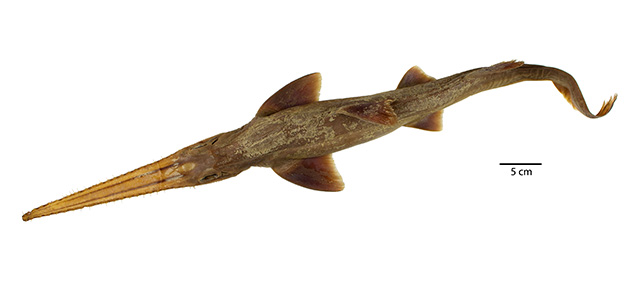| Pristiophoridae (Saw sharks) |
| 170 cm TL (male/unsexed) |
|
demersal; marine; depth range 10 - 915 m |
| Western Indian Ocean: off Madagascar and from southern Mozambique to Cape Agulhas, South Africa. |
|
This large six-gilled sawshark is distinguished by the following characters: barbel origin to anterior nostrils 1.4-1.6 times anterior nostrils to symphysis upper jaw; prenarial length 1.3-1.4 times prebarbel length; preoral length 1.8-2.3 times interdorsal space; pectoral-fin anterior margin 1.4-1.5 times dorsal-caudal space; mouth width 3.1-3.9 times spiracle length; the first dorsal fin originates about opposite pectoral-fin free rear tips; lateral trunk dermal denticles tricuspidate, rather flat and imbricated. monospondylous centra 53-56; precaudal diplospondylous centra 4-51; total vertebral centra 154-158; rostrum not constricted between barbel origin and nostrils and barbels that are situated about two thirds way from rostral tip to mouth, with prebarbel length about twice, i.e. 1.7-2.1 times, distance from barbel origin to symphysis of upper jaw (vs. barbels situated about half way from rostral tip to mouth, with prebarbel length about equal, i.e. 1.0-1.1 times, distance from barbel origin to symphysis of upper jaw), prebarbel length 60.2-68.0% (vs. 49.4-52.9% of preoral length), preoral length 1.5-1.7 (vs. 1.9-2.0 times prebarbel length), prenarial length 1.3-1.4 (vs. 1.5-1.7 times prebarbel length). Colouration: medium to dark brown dorsally with a pronounced yellowish longitudinal stripe; uniform white ventrally; the dorsal rostrum surface with two distinct longitudinal dark stripes, lateral rostral teeth dark-edged (Ref. 122027). |
| Found on the continental shelf and upper slope to at least 430 m (Ref. 247). Feeds on bony fish, also shrimp, mysids and squid (Ref. 5578). Ovoviviparous (Ref. 50449), with 5 to 7 young in a litter (Ref. 247). Probably uses its saw to stun and kill prey (Ref. 5578). Sometimes caught by sports anglers (Ref. 5578). |
|
Least Concern (LC); Date assessed: 16 September 2019 Ref. (130435)
|
| harmless |
Source and more info: www.fishbase.org. For personal, classroom, and other internal use only. Not for publication.

